
E-mail: font@focusonnature.com
Phone: Toll-free in USA 1-888-721-3555
or 302/529-1876
 |
PO
Box 9021, Wilmington, DE 19809, USA E-mail: font@focusonnature.com Phone: Toll-free in USA 1-888-721-3555 or 302/529-1876 |
Highlights
FROM some PREVIOUS
FOCUS ON NATURE TOURS
in ICELAND
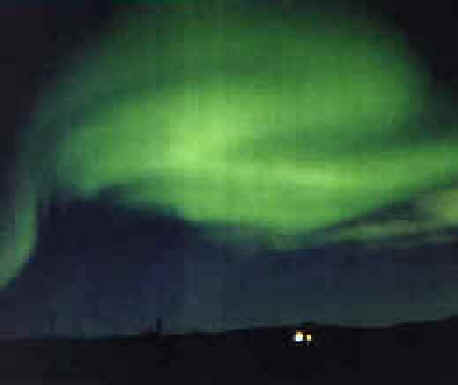
The "Northern
Lights" or Aurora Borealis (called "Norourljos" in Icelandic),
seen during FONT tours in Iceland in October.
More
regarding the "Northern Lights"
The
tour summaries here are given with the most-recent tours first.
For some tours there are links for longer NARRATIVES. Also there are links to UPCOMING TOUR ITINERARIES,
and lists (some with photos) of BIRDS, MAMMALS, and OTHER NATURE.
Previous FONT Tours:
June
2015 September/October
2013 June 2012
June 2011
June
2009
September/October
2008 September/October
2006 June
2006 June
2003
May-June
2003 October
2002 June
2002
In all,
there have been 20 FONT birding and nature tours in Iceland
Links:
Birds
during previous FONT Tours in Iceland
A
Complete
Iceland Bird-List
(387 species, including vagrants from mainland Europe, Asia, & North
America)
A List & Photo Gallery of European Birds, in 2 Parts:
Part #1: Grouse to Puffin Part #2: Sandgrouse to Buntings
Marine Life in Iceland (with some photos)
Wildflowers & some other Plants of Iceland (with some photos)
Northern Wildflowers & some other Plants (including those in Iceland) by Families
PHOTO
GALLERIES of Icelandic Nature, Scenery, and Culture
from FONT tours in: June
2015
Sep/Oct
2013 Jun 2012
June 2009
June 2006
Upcoming FONT Birding & Nature Tours in Iceland
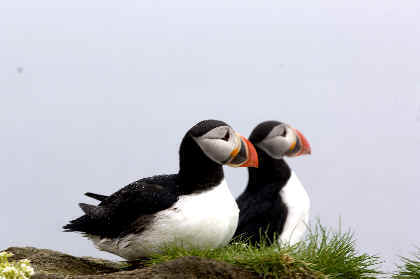
Atlantic Puffins in Iceland
![]()
ICELAND - June 2015
Links:
Photos of Nature & Scenery from our June 2015 Iceland Tour
Photos of Birds from our June 2015 Iceland Tour
List of Birds & Other Nature during the FONT Iceland Tour - June 2015
![]()
ICELAND - September/October 2013
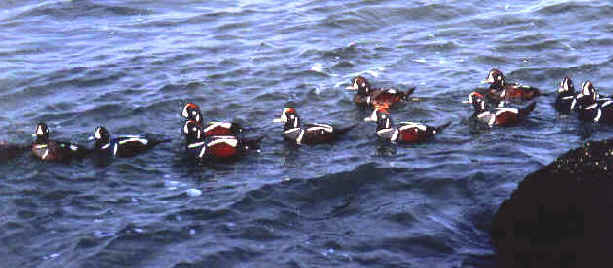
A string of male
Harlequin Ducks
The FONT Fall
Tour in Iceland in September/October
2013 was our 19th birding & nature tour in that country.
Even though there have been that many FONT tours there in the past, during both
September/October and May/June, this tour was different than any other.
We traveled the circumference the island, along the
"ring road", during our week or so in Iceland. We've done
that previously, so that's not different. But again, it was a great way to see
"so much" of Iceland.
And, as we did, we had a wonderful time. And once again, that's not different
than during our previous Iceland tours, as we've had wonderful times in the
past.
But, along the way, we went to some interesting and scenic places, not visited
during previous tours, as we saw and experienced such a mosaic of colorful
and striking scenery, fascinating geology, seascapes, tundra, glaciers,
waterfalls, thermal sites, good Icelandic food and culture, along
with of course the birds and other nature.
62 species of birds were seen during the tour. Of them, 6 were "new
species" for FONT in Iceland, bringing our cumulative total to 110
species.
Among the 62 species, 11 were gulls, including, as we were having
lunch by a harbor in a picturesque small fishing village, a Sabine's Gull
and 2 Little Gulls together with the more numerous gulls, mostly Black-headed,
while later that day, at another place, on glacial icebergs, with other gulls,
including Iceland, and again mostly Black-headed, there was a
completely "new species" for Iceland, a first-winter Mediterranean
Gull.
Among the birds most enjoyed during our tour were the flocks of Common
Eiders, Barrow's Goldeneyes, and Harlequin Ducks, as well as those of
Whooper Swans, along with 3 species of alcids, including, for the
first time for us in Iceland, the Dovekie, or Little Auk, and 2
species of godwits: the Black-tailed Godwit, an brightly-colored
subspecies endemic as a breeder to Iceland, that was about to leave the
island, while the Bar-tailed Godwit, a non-nester in Iceland that had
just arrived from Norway.
Especially enjoyed was the strikingly beautiful Long-tailed Duck, a bird
now classified by Birdlife International as a "threatened
species".
Two "Icelandic Wrens" near us as they popped in & out of a
rock jetty, along the far eastern Iceland coast, as well as one that sang its
song in a beautiful Icelandic forest, were treats.
Some birds that we've found during our autumn Iceland tours previously eluded
us this time.
For example, we saw not one Snow Bunting.
But we did see more Redpolls that usual, at various places throughout the
island.
Of course, most (actually, nearly all) were Common Redpolls, including
the Iceland endemic subspecies "islandica".
But a couple birds, at the beginning of the tour, were of an interesting race of
the Arctic (or Hoary) Redpoll. Those birds, pale "Greenland,
or Hornemann's Arctic Redpolls" were nearly as white as snowflakes.
Also, we did not, unfortunately, cross paths this time with a Gyrfalcon,
but during one remarkable scenic ride in northeast Iceland, we did enjoy as many
5 different Merlins, the other, smaller falcon that breeds in Iceland.
Also different than during all of our other Fall FONT Tours in Iceland
was that the "Northern Lights", or Aurora Borealis, was
not meant to be.
Such activity in the nocturnal sky in October 2013 was less and more limited
than usual in the Northern Hemisphere than it has been during other years, but during our last night, which was
so very clear, we saw stars, from horizon to horizon, and the Milky
Way overhead, for us as "never before". It was truly memorable,
especially as we stood, miles away from any city lights, but right next to a geyser
that periodically lifted a hundred feet or so into the air.
Links:
More about the FONT Iceland Tour in Sep/Oct 2013
Photos of Scenery & Birds from our Sep/Oct 2013 Iceland Tour
List
of Birds & Other Nature during the FONT Iceland Tour - Sep/Oct 2013
The
following commentary was received at FONT by e-mail following our Sep/Oct 2013
Iceland Tour
from one of the participants:
"Armas,
I want to tell you how much I enjoyed the trip - I couldn't have asked for a
better experience.
With birds, waterfalls, glaciers, geysers, hot springs, fall colors, black sand
beaches, rocky coastlines, and rugged highlands. Plus a few adventures!
Maybe we'll have a chance to travel together again."
Alan
Virginia, USA
![]()
In June 2012, we truly had a wonderful
and enjoyable tour in Iceland. We circled
the entire island, counter-clockwise, and then some as we went to the
westernmost point in Iceland, the impressive Latrabjarg
Cliffs where we saw thousands of
nesting seabirds including Fulmars, Kittiwakes, both Common
and Thick-billed Murres, and the favorite of most, the Atlantic
Puffins.
While Iceland itself is of course an island,
the fourth largest island in the Atlantic, and called
Island by the locals, we visited two notable smaller Icelandic
islands during the tour: Flatey in the big
bay known as Breidafjordur, and Heimaey,
one of formerly 14, now 15 islands in the Westmann
Islands group. At both we also enjoyed, again, that favorite of most, the Puffin.
Also during the tour we were at the most powerful waterfall in Europe,
the largest glacier in Europe, and the lake with the most ducks
of any in the world.
We saw volcanoes and more waterfalls, and many birds
in addition to those already mentioned, as well as other wildlife too including 2 Blue
Whales, the Northern Minke Whale, White-beaked Dolphins, 3
Arctic Foxes, both Gray Seal and Harbor Seal, and Reindeer,
as well as an assortment of wildflowers.
All of these natural aspects of Iceland were in addition to some fine
food and Icelandic culture (and wonderful weather).
During our last day, which was the Icelandic Independence Day, prior to
our departing flight, we were in the capital city of
Reykjavik, where the Icelandic people, young, old, and in between,
and with some in old-time garb, paraded down the main street, commemorating their
country's national holiday.
When our tour was finished, we all felt that we had really experienced
Iceland, one of the most beautiful places on Earth, in so many ways.
Here, I have just skimmed the surface as to our FONT Iceland
tour in June 2012, our 18th tour
in that country. To read more, please click the link below for a more-complete
narrative.
Links:
More about the FONT Iceland
Tour in June 2012
Photos of Birds & Other Nature from our June 2012 Iceland Tour
List of Birds & Other Wildlife during our Iceland Tour - June 2012
![]()
Our Iceland tour in
June 2011
was the 55th FONT tour in Europe, and our 17th tour in Iceland, where
we've conducted birding and nature tours during both
the late-spring and the early-fall.
On one afternoon during the tour, we were along the
northern Icelandic coast, right by the Greenland
Sea.
In a small pool there, of cold water, a pair of little Red-necked Phalaropes,
about 7 inches in length, were spinning around and flitting about.
In the next small pool to the right, there was warmer water, and in it a pair of
people, an Icelandic couple, enjoying the geothermal heat.
To the right, closer to the very cold sea, there was a warmer pool yet. It was that
small pool of hot water that those in our group, who took a dip, enjoyed the
most.
That duo of dapper little Red-necked Phalaropes would be there for only a
relatively short time, just a few weeks to nest and raise their young. Then,
they would fly away, to go to the ocean where they would winter by the Arabian
Peninsula.
In the warm geothermal pools, we would be for just a short while, before a few
days later, heading back to places such as Atlanta and Los Angeles.
But it was another creature in the area that would be traveling the furthest.
After the Icelandic couple lifted out of the pool, they walked north along the
nearby coastline, where, from the stones, a mass of shrieking Arctic Terns
rose into the sky. That cloud of birds circled about loudly overhead. They were
nesting among those stones, and when their breeding season would finish, later
in the summer, they would fly away, but to go further than any bird on Earth,
traveling over the ocean south rounding the southern tip of Africa and
continuing east into the Indian Ocean.
Offshore from the stony coast, there was a rocky islet rising abruptly from the
sea. On it, out there, a pair of Gyrfalcons was nesting, and there were
breeding Atlantic Puffins atop the cliffs and sitting on the adjacent
sea. Those oceanic waters were also the haunts of creatures such as the Greenland
Shark, other fish, the Harbor Seal, and various whales and dolphins.
Described here was just one of the places that we visited during our tour. To
read about others, and for more interesting information about the Atlantic
Puffins in Iceland, please click the link below for "More about the
FONT Iceland Tour in June 2011".
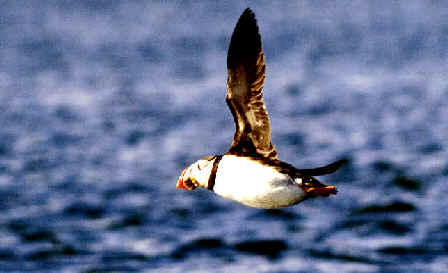
The Atlantic Puffin was seen during the FONT June 2011 Tour in Iceland
Links:
More about the FONT Iceland
Tour in June 2011
List of Birds during our Iceland Tour - June 2011
![]()
During the second
week of June in 2009, this was the 16th FONT
tour on the island known as Iceland, the
fourth largest island in the Atlantic Ocean and truly a wonderful place to see
& experience a varied assortment of nature. Only on this island is the
geological phenomenon called the Mid-Atlantic Rift to be seen, as we saw
it, above the water of the ocean.
Throughout the island, with its magnificent scenery, there's fascinating geology
and topography with lava
fields, volcanoes, waterfalls, glaciers, and a geyser
or two. Whether it was when we were along the seacoast, or in the interior, the
countryside was, for us on the tour, like being, simply put, in
"another world".
And in those varied places that we visited there were always birds. Our
"favorite" was the Puffin. From the front of a boat, we were
close enough to be nearly "eye to eye" with those
"parrot-headed" little seabirds on the top of a small island, as they
popped out of their burrows, shook their wings, and then looked just-plain
"cute"! Everyone liked the Puffins! It could not have been
otherwise.
Other birds also were enjoyed during the tour, as we observed either from our
vehicle, or walking about, or looking from a boat - birds such as: the Ptarmigan
that we saw well, the 2 White-tailed Eagles (an adult and a juvenile),
the greenish-hued Shags with their young (so very little!), the
flocks of gaudy Harlequin Ducks, the bold Great Skuas, their
cousin the Parasitic Jaeger, and the shorebirds (or waders)
at their nesting sites, including : the brightly-colored Black-tailed
Godwit, the European Golden Plover, with its plaintive call, the Whimbrels
with their melodious song given in flight, and of course the master of these
birds with a flight display, the Snipe.
We saw overall hundreds, probably a few thousand, Common Eider - a treat
to see. But a special treat was a single male King Eider!
As participants wrote at the end of the June 2009 Iceland tour: In addition to
the birds, we liked so much "the pastoral countryside, with picturesque
farms and churches, along with Icelandic horses, sheep and lambs,
white swans in green pastures, beautiful and delicate wildflowers,
and so many configurations of lava". Just as we liked "our Icelandic
dinner of leek soup, cod with sauce, and a rhubarb dessert" and our good
times throughout the tour with "our gregarious and happy group".
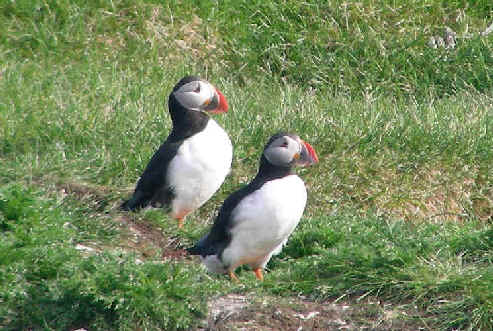
These Atlantic Puffins were
photographed
during the FONT tour in Iceland in June 2009.
(photo courtesy of Gerin Hood)
Links:
More about the FONT Iceland Tour in June 2009
Photos
of Nature & Culture during our June 2009 Iceland Tour
List of Birds during our Iceland Tour - June 2009
Wildflowers of Iceland_ (with photos from the June 2009 FONT tour)
![]()
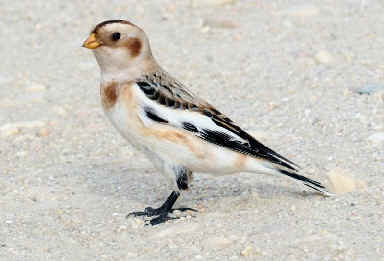
The Snow Bunting is one of the
landbirds
that we see during our Iceland tours.
ICELAND - September/October
2008
During our week in Iceland, Sep 28 - Oct
6,
2008, there was so
much diversity in the nature that was around us.
Part of the country was still green,
with moss on volcanic rocks. There were rainbows and waterfalls.
And geysers and glaciers.
In the north, there was an early
snowfall. Above snow on the slopes of the hills, after dark, there were
beautiful displays in the sky of Aurora Borealis, or the Northern
Lights.
As white as the snow, was an Arctic Fox, close to us. Its nose and the
tips of its ears were black.
We saw at least 3 adult Gyrfalcons. One flew completely around us as we
were in our vehicle. A couple minutes later, it was chasing another Gyrfalcon.
The Ptarmigans that we saw were turning white.
Among other birds that were highlights were flocks of Barnacle Geese,
Harlequin Ducks, and Barrow's Goldeneyes.
This birding & nature tour was the 15th for FONT in Iceland.
During it, 5
new species of birds were added our cumulative list during tours in that country
(bringing it up to 101 species):
Buff-bellied (or American) Pipit (an
Icelandic rarity), American Black Duck, American Wigeon, Common Blackbird
(not at all common in Iceland), and Red Crossbill.
One morning, we
had an enjoyable time watching about 20 of the last of these, the crossbills,
along with about a dozen Eurasian Siskins, and many Redpolls.
There was a good crop of cones in the spruce trees. And, now, with more such
trees in Iceland, there are more birds there such as the crossbills and siskins.
Continue reading, if you would, about more of what we saw and experienced in Iceland during our 2008 fall
tour in that wonderful country for nature.
Links:
More about the FONT Iceland Tour in Sep/Oct 2008
List of Birds during the FONT Iceland Tour - Sep/Oct 2008
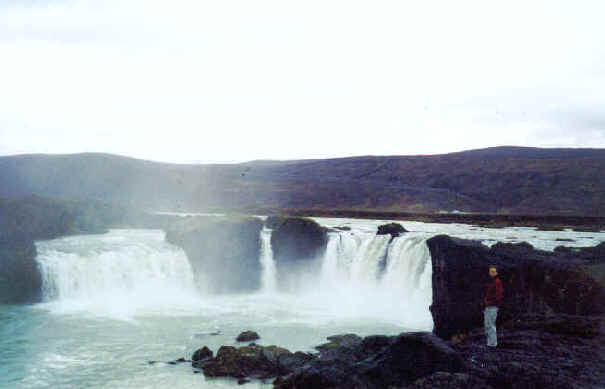
The waterfall known
as "Godafoss", one of a number that we saw in Iceland
during our Sep/Oct 2008 tour.
![]()
ICELAND - September/October
2006
This was the 14th FONT birding
& nature tour in Iceland. In October, migrating birds from both mainland
Europe and North America can occur in Iceland. Among them, during this tour, we
saw from America: Sabine's Gull, Snow Goose, and Long-billed Dowitcher,
in addition to the birds of Europe, and those that are specialties in Iceland,
including: White-tailed Eagles (we saw 5), Iceland Gull, Great
Skua, and Harlequin Ducks.
Among the best of the waterfowl was a large flock of dozens of Barrow's
Goldeneyes (both males & females) riding the rapids of a stream.
Our waterfowl included 5 species of geese.
Non-avian fauna included a tremendous male Caribou, with a huge rack of
antlers.
After dark, we saw a wonderful display of Northern
Lights, and one afternoon there was a
brilliant rainbow
over the beautiful volcanic countryside. The rainbow, as bright as
one can be, was complete, and partially double. It was one of the fine sights
that we had during the tour.
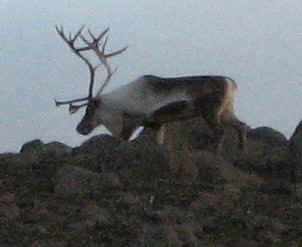
Above: A Reindeer
at Dusk
(Photograph taken during the FONT tour in Iceland,
in October 2006, by Claude Bloch)
Below: The Aurora Borealis, or Northern Lights
in the Icelandic Sky at Night.
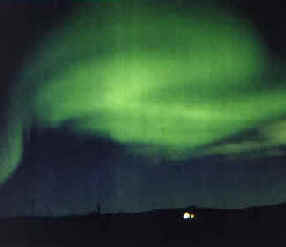
Links:
More about the FONT Iceland Tour on September/October 2006
List
of Birds during our Iceland Tour - Sep/Oct 2006
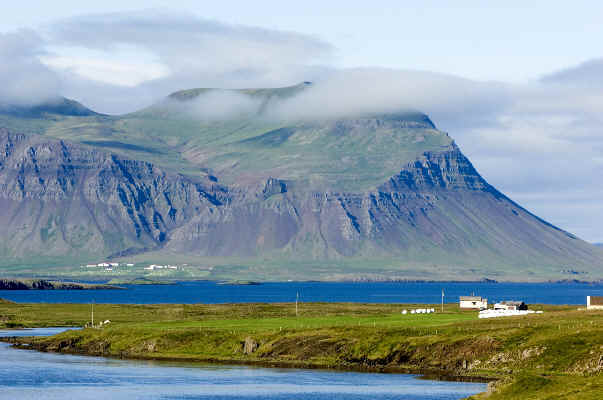
Icelandic scenery, during our Fall
'06 Tour
![]()
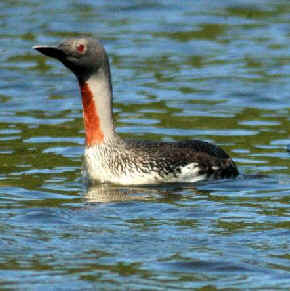
Red-throated Loon
(photo by Howard Eskin)
During this, our 13th birding
& nature tour in Iceland, there were a number a highlights, including: male
and female Gyrfalcons seen cliff-side, a Yellow-billed Loon (unprecedented
for Iceland) close to a ferry-boat, a White-tailed Eagle flying
around us as we were on another boat, a male and a female King Eider on a
beach along the Icelandic north-coast (as very unusual occurrence in
Iceland), Red Phalaropes (3 breeding-plumaged females) near
their nesting site, Snow Buntings feeding their young.
These were in
addition to lots of wonderful looks at the "regulars" including: Puffins
on grassy cliff-tops and on the water (during the tour, there were many
Puffins), other alcids including 2 species of Murres, Razorbills,
and Black Guillemots, plus colorful Harlequin Ducks in rushing
streams, pairs of Red-throated Loons in breeding attire, more Snipe
winnowing in the sky than could be imagined, both light and dark Parasitic
Jaegers, and as many as 100 Great Skuas during less than a half-hour
as we traveled one evening along a highway.
Iceland has its share also of
"strays". The best of those that we saw was a drake Garganey.
Birds are just one aspect of nature to be experienced in Iceland. There's also
fascinating geology, wildflowers, and the largest
glacier in Europe. Mammals during our tour included: a dark Arctic
Fox, Minke Whales (from shore), and Harbor Seals.
This was, as noted,
our 13th Iceland Tour, but if there were "luck" with it, it was good.
Links:
More about the FONT Iceland Tour in June 2006
Photos of Icelandic Birds & Scenery from our June 2006 Iceland Tour
List of Birds during our Iceland Tour - June '06
A List of Birds during FONT Iceland Tours
A Complete List of the Birds of Iceland
Upcoming FONT Birding & Nature Tours in Iceland
![]()
ICELAND - June 2003
with Gyrfalcons & Goldeneyes,
Puffins, Phalaropes & Ptarmigan
The following account written by Armas Hill, leader
of the tour.
Beautiful, often spectacular, Iceland
is quite a
place. Clean and pristine, it's with coastlines, moors, mountains, valleys,
waterfalls, volcanos, and glaciers. Travel into the countryside of the island,
where people are few, is something enjoyed at the time, and remembered for a
long time afterwards.
We've now conducted
11 FONT tours in Iceland. Our next tour there, number 12, will be in October. The bird-life is interesting then also, but different than it was during our just-completed 11th tour, June 4-10, 2003.In
October, birds are migrating, or preparing to do so. Many of them are in flocks Golden Plovers, Redwings, Whooper Swans together in numbers. Groupings of geese of various kinds are passing through, on their way south, from Greenland. Purple Sandpipers are together along rocky shores, with Harlequin Ducks in the coastal waters. And then on clear nights in October, there are spectacular displays of "Northern Lights" or Aurora Borealis.But in early
June it's very different. Birds are breeding, and generally spread out over the countryside. As we drive along, Golden Plovers, on territories, give their plaintive songs. Whimbrels, their melodious fluting trills. Dunlin display, raising their wings. Black-tailed Godwits are on pools, the race in Iceland with a stronger red coloration than other populations. Oystercatchers can't help but be striking. Redshanks tend to get attention by alighting atop posts and calling loudly. And Snipe do more than that. Their winnowing overhead is a constant in the Icelandic countryside. There must be thousands & thousands of Icelandic Snipe. They could be heard and seen virtually anywhere we stopped, day or night.But, oh yes, in Iceland in early June there really is "no night". Close as it is to the Arctic Circle, during our entire time, there was no actual darkness. A bit dimmer at let's say 2 o'clock in the morning, but not dark enough for stars.
Some birds during those dimmer hours seemed to rest, but not all. Arctic Terns still screeched as they flew. A Short-eared Owl hunted. In bushes in small towns, the thrush known as the Redwing, gave its flute-like song. And throughout the land, those ever-present Redshanks called, and Snipe winnowed, as much as ever.
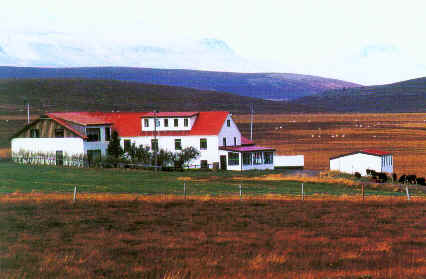
Phalaropes and Ptarmigan were among the birds in the northern Icelandic countryside. The former, daintily-built but boldly-patterned, were on roadside pools, the Red-necked Phalaropes. The Ptarmigan is one of 27 or so subspecies throughout the Northern Hemisphere of Rock Ptarmigan. That species ranges, in isolated populations, in mountains such as the Pyrenees and the Japanese Alps, and on islands, often remote, from the Aleutians to Newfoundland, Greenland, and Iceland. We saw them well, on the ground and in flight, the strong fast fliers they can be. And need to be, apparently, to escape their predator, the Gyrfalcon.
As with our previous tour number #10, a week earlier, we had the very good fortune of seeing Icelandic Gyrfalcons, at their nest, on a cliff-side in a river gorge. Through a scope, from the far side of the gorge, we saw well two white baby gyrs at the nest, and the accompanying light-gray adult female. We also saw the male, flying rapidly out above the adjacent vast terrain. His role, we assumed, was to catch a meal. Her role, in the gorge, to protect the chicks. It was a wonderful experience for us, in an area of wilderness.
A turn of the telescope, there, showed us another bird on its nest. It was a Pink-footed Goose that truly blended into the tall grass. Not much more than the head of it, and its mate a few feet away, were visible. But the distinctive beaks, of those geese ever so still, could be readily seen. Many of the Pink-footed Geese of the world nest in the remote highlands of Iceland. The rest, even more remotely, in Greenland.
We spent the night at a nearby farm, with facilities for guests, where outside the door there was "nothing" for miles, other than an open countryside with some sheep and Icelandic horse, and birds!
In contrast with the Pink-footed Geese
that we saw, Greylag Geese were obvious and vocal throughout the
countryside. Often with goslings.
Some Whooper Swans were in flocks, non-breeders. But a number of them
were in pairs, some with their cygnets.
Along shorelines some of the plentiful Common Eiders had their ducklings.
And there were waterbirds of various sorts on lakes, ponds, and streams,
including colorful Horned Grebes in breeding attire, both Red-throated
and Common Loons, and many, many, ducks.
Certainly among the best in the duck department was the Harlequin. The beautiful drakes that we saw, a few times, in fast-flowing river waters, were sights not to be forgotten. And never tiring to see.
In eastern North America, birders look at
times for a single Barrow's Goldeneye in a flock of many Common
Goldeneyes. In Iceland, we did the opposite. On a still-watered lake, in a
magnificent volcanic setting, there was a large flock of Barrow's Goldeneyes.
With maybe a few more males than females (that may have been on nearby nests).
Among the big group, there were two male Common Goldeneyes, that species
not common at all in Iceland.
There's something interesting about the nomenclature of the Barrow's
Goldeneye. It's scientific name is Bucephala (as in Goldeneye) "islandica".
Thus, named after Iceland, even though the species is most common in the
American West. In Europe, the Barrow's Goldeneye occurs only in Iceland.
Regarding it's common name, the Barrow's
Goldeneye is named after Sir John Barrow, an Englishman, who lived from 1764 to
1848. He was, for many of those years, the Second Secretary to the Admiralty in
the Royal Navy, and quite instrumental, in London, for the British exploration
in the search of the North-West Passage through northern North America.
Point Barrow in Alaska and the Barrow Sound and Barrow Straits in the Arctic are
named after him.
From London, John Barrow was largely responsible for the Arctic expeditions by
James Clark Ross, Edward Sabine, and John Franklin (all of whom had gulls named
after them). But the duck, the Barrow's Goldeneye, was named after a man, back
in London, who never actually saw it in the wild. We did, nicely, in Iceland,
where it's said that about 800 pairs occur.
Of all the birds in Iceland, during the breeding season, it's the seabirds that are far and away the most plentiful. They are present in the millions.
One of our ventures, during the tour, that was most enjoyable was a walk on a cliff-top, along the north Iceland coast, on a peninsula, with a lighthouse, and Puffins. Their burrows, lined up like condos, were at our feet. Some of the comical-looking creatures flew out of the holes much like bullets as we approached. Others stood, a bit further from us, on the grass. Below, on the water of the ocean, there were hundreds and hundreds of Puffins. Some riding the waves, some diving for food, and others feebly flying about. It was for us another marvelous experience.
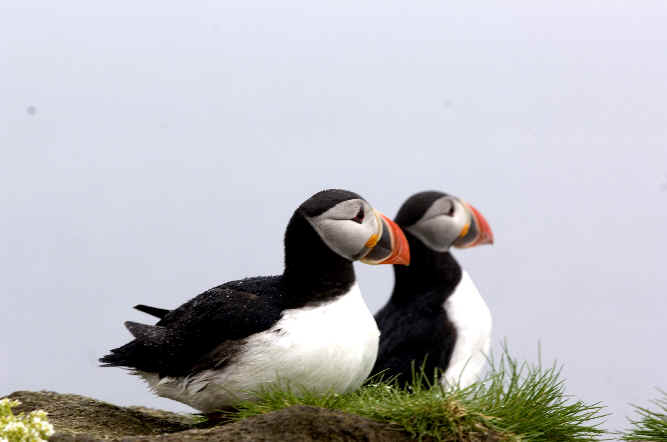
At another place along the Icelandic coast, on the south side of the island, other alcids were represented Murres (of 2 species) called Guillemots in Europe, the Black Guillemot (Americans and British agree on that name), and Razorbills. More Razorbills occur in Iceland than anywhere else in the world. Out to sea in the distance, from that spot, we could see a rocky island, called Eldey. It's reputed that on that island another alcid, now extinct, last occurred in 1844. It was the flightless Great Auk. Our tour was only a century and a half too late.
The Icelandic seabird that now seems the
most common of all, let's say abundant, is the Northern Fulmar. It is in
large numbers on cliffs throughout the island. Atop one particular cliff along
the north coast, we had eye-to-eye looks at Fulmars on their nests, although we
saw them more distantly many places. They are fun to watch in flight, with their
alternate flapping and gliding, even in stiff winds.
But oddly, back in those days when the Great Auk occurred, the Fulmar was a
rarity in Iceland, occurring in 1750 on only one offshore island (Grimsey), and
then recorded nesting on mainland Iceland for the first time about 30 years
later. Today, there are millions of Fulmars in Iceland in the summer.
Other seabirds that occur in big numbers,
that we saw during the tour, were Kittiwakes, Gannets, Arctic Terns, and Lesser
Black-backed and other Gulls including Glaucous.
And there were Parasitic Jaegers and Great Skuas.
We stayed a couple overnights in a small,
kind of out-of-the-way, village, on the northern seacoast, where the hotel,
favored by fishermen, was by the mouth of a river renowned for its salmon. The
beach and the ground by the rivermouth was dark. It was an exact match for two
dark-morph Parasitic Jaegers as they sat not far from a large noisy group
of Arctic Terns. During the tour, we had great looks at both dark and
light morph Parasitic Jaegers.
On that same dark soil, by the hotel and the river and ocean, one morning, a Great
Skua sat.
Yes, Iceland was a great place to be.
Some of the smaller birds that we saw
were notable:
Snow Buntings were in their
dapper breeding plumage. A male, giving its song, was the first bird we saw by
the parking lot at the airport.
An Icelandic version of the Winter Wren was heard giving its song in
rocks above water, along the
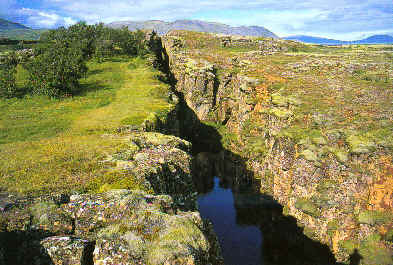
Mid-Atlantic Rift
In trees
(where they were to be found), we sometimes found Redpolls. There are
taxonomists who now tell us that those residing in Iceland are "split"
from the Common Redpoll to be the endemic Icelandic Redpoll, Carduelis
islandica.
In one Icelandic forest, in addition to Redpolls and Redwings, we found a Eurasian
Siskin, and in conifers, a pair of Goldcrests. The latter was also
seen during our tour a week earlier. The Goldcrest, the smallest of European
birds, was only recorded as an Icelandic breeder as recently as 1999.
Our "top 10 birds", as we voted them, at the end of the tour, were
1 - Atlantic Puffin
2 - Gyrfalcon
3 - Harlequin Duck
4 - Horned Grebe
5 - Pink-footed Goose
6 - Barrow's Goldeneye
7 - Red-necked Phalarope
8 - Great Skua
9 - Snow Bunting
10 - Black-tailed Godwit
In all, 20 species of birds received votes. In all, nearly 70 species were seen.
But it was not just the birds, but other aspects also, that made it a fine tour indeed, during which we had a terrific time.

The waterfall known
as "Godafoss", one of many in Iceland.
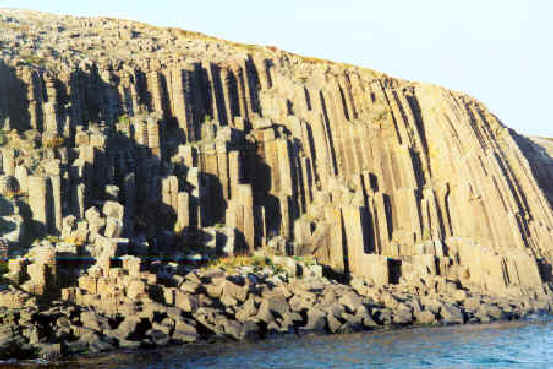
Basalt columns, one of
numerous geological formations in Iceland.
Upcoming FONT birding & nature tours in Iceland
![]()
ICELAND - May/June 2003
with A Solar Eclipse, and Gyrfalcons & Goldcrests
The following account written by Armas Hill, leader of the tour.
Our 10th FONT birding tour in Iceland
ended on June 3, 2003. It was the first of two tours there this late-Spring 2003.All of the birds we hoped for were seen, and more!
The morning of the last day in May, in
one of our favorite Icelandic fishing towns, Stykkisholmur, began with a sunrise
at 330am. We were up, as it was not an ordinary sunrise that day. As the large,
orange ball near the horizon was going higher, the shadow of the moon began to
cross it. Think of an orange half, then crescent sun.
Due to the eclipse's path being by
the Arctic Circle, the moon's shadow moved across the sun in the direction
opposite that of "normal solar eclipses". The approximately 3-minute
period of totality was just after 4am. During that period, the sky was darker
than it had been just after 3am.
In 2003, there would be two solar eclipses, the one that we saw over the
Arctic, and another to be late in the year over the Antarctic. Our Icelandic experience was the 5th solar eclipse, during a FONT birding tour, since 1991. The others have been in Costa Rica, Bolivia, Venezuela, & Turkey.In Iceland, during our
May-June 2003 tour, not only was there nature in the sky with the eclipse, but also we visited a place where the Mid-Atlantic Rift, usually beneath the ocean floor, can be experienced at the surface of the land. It's a nearly unique occurrence. Along the Mid-Atlantic Rift, the North American and European Continents are ever so slowly drifting apart. As we were there, at a rocky, rushing stream, there was a striking male Harlequin Duck. Interesting, actually, as the Harlequin is one of 2 species of Duck, predominately American, that occur in Europe only in Iceland. The other is the Barrow's Goldeneye.One of our most-exciting times during this Iceland tour was by another rocky stream, out in some vast open countryside. Just below a waterfall, the stream went through a deep, rocky gorge. From one side, we had a telescope view that nearly filled the frame, of a light-colored, female Gyrfalcon on a ledge, next to 2 fluffy, white Gyrfalcon fledglings. We'll never forget that sight.
Later that day, we were walking in an Icelandic forest of mostly short conifers. There are not many forests in Iceland, but there are some. In it, Icelandic Redpolls and Redwings (a European thrush) were common. But there were also the high, wispy sounds of another bird, Europe's smallest, the Goldcrest, one of the kinglets. Close to us. We saw one with the gold crest, and then another fluttering, just learning to fly. What bird is smaller than the Goldcrest? A baby Goldcrest. The species was found to breed in Iceland only as recently as 1999.
A couple days earlier, we saw Iceland's largest bird, a female White-tailed Eagle on its nest. The male stood, in the open, on a nearby ledge. The pair on a rocky island on a big bay. We saw the birds during a wonderful boat-ride during which we also saw thousands of Puffins, on clifftops, on the surface of the water, and in flight. Other North Atlantic alcids we saw comparably well during the tour.
When we were standing on a clifftop, during another sunny day, we looked down at Fulmars (many of them) sitting on their nests. Further down, on the surface of the ocean, we saw Great Skua feeding on a floating carcass, Red-throated Loons, and many, many Eiders.
A few miles further, along a dirt road, we had the best possible look at a pair of Rock Ptarmigans, the mostly-white male with bright red eyebrows. The brown female blended in with the terrain. Both were just outside the windows of our van.
Further along, during our ride, were Red-necked Phalaropes, also close, spinning around on roadside pools. After passing through one of a number of Arctic Tern colonies, we saw, in a stony area, some nice Snow Buntings in breeding plumage.
Along another road that day, in an area of meadows, we had a close encounter with a Short-eared Owl, as more Snipe than imaginable were winnowing in the sky. At one time, 14 snipe were counted above us. Ravens flew by, adding their sounds to the mix.
Over 70 species of birds breed in Iceland. We saw nearly all. The list of vagrants in Iceland is long, and we came across a couple Great Crested Grebe and Grey Heron (the heron occurs more normally in Iceland in the winter). Migrants still on their way farther north included shorebird flocks with Turnstones, Sanderling, and Red Knot.
Lastly, we were fortunate in May to see an Iceland Gull in Iceland. That species actually nests, not in Iceland, but further north in Greenland.
Upcoming birding & nature tours in Iceland
![]()
The following account written by Armas Hill, leader of the tour.
FONT has conducted a birding
tour in Iceland, during October, annually since 1996. Our October '02 tour was
the second FONT tour of the year on the scenic and interesting island, with the
other tour having been in June.
In June, Icelandic nights are short indeed. In fact, at midnight, during our
June tour, the red ball of the Sun was above the horizon. In October, daylight
lasts from just before 8 o'clock in the morning to about 7 o'clock in the
evening. That gives us ample time to see some fine birds during the day, and
something to look forward to after dark: marvelous displays in the sky of Aurora
Borealis, or "Northern Lights".
For those of us on the night-time flight enroute to Iceland, outside the window
on the left side of the plane, a strong display of the Northern Lights was quite
a sight. Viewing from about 30,000 feet in the air, the waves of floating green
light were something to see, like tall curtains.
Our first two nights in Iceland were unfortunately cloudy, but on the third
night, when we were far away from any ground lights, we stepped out of our
vehicle, and looked up, this time from ground-level, at a sky full of those
waves of floating green light. It was a long and wonderful show above us. The
Northern Lights are known in the Icelandic language as "Norourljos".
It's a great sight to see, yes, but also, at least for those of us not
Icelandic, the word's a mouthful to say!
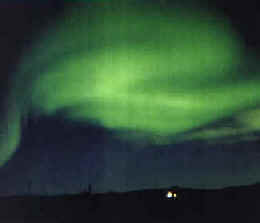
"Norourljos" or
Northern Lights
During the days of our tour, we enjoyed those fine birds we sought, also nice sights to see. Among them were numerous eiders, some colorful Harlequin drakes, Barrow's Goldeneye, groups of Whooper Swans, and a few wonderful close looks at Rock Ptarmigan. Flocks of Purple Sandpipers and European Golden Plovers were close to us. Gulls, of various species, were plentiful. There were many Glaucous Gulls, in assorted plumages. We also saw Iceland Gulls in Iceland. In the summer, that can not be done. The Iceland Gull does not nest in Iceland. It arrives there in October from Greenland.
One afternoon, during a boat-trip in a picturesque area of a large coastal bay, dotted with small rocky islands, we had the good fortune to see 2 adult White-tailed Eagles, certainly symbolic of the remote area where we were. Earlier in the day, a White-tailed Eagle had flown directly in front of us as we traveled along a dirt road, with the bay on one side and cliffs on the other.
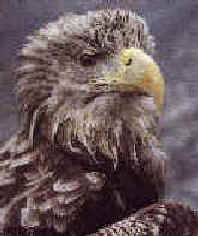
Adult White-tailed
Eagle
Also great to see, from the boat
on the bay, were a number of Black Guillemots (not-so-black in October),
and a boldly-patterned pair of Long-tailed Ducks.
Unusual during our Iceland tour, this year, were 5 Grey Herons. The
species does not normally breed in Iceland, but in the autumn a few might wander
to Iceland from Norway. Another autumnal wanderer from Norway that we saw was
the Eurasian Curlew. It was along a coastline not far from some Wheatears
and Meadow Pipits that were about to depart for the European continent.
Landbird species are few in Iceland, but among others that we saw were Redwings
and Redpolls. The former were particularly common, gathered in large
flocks about to begin their migration to the British Isles. Redwings are
thrushes.
However, this year, the most interesting of the landbirds were starlings,
yes, starlings: Rose-colored Starlings. We saw 3 of them in a
small town in northwestern Iceland. They were in the company of some Common
Starlings. That species, itself, is a rather new addition to the avifauna of
that area, having spread there only recently from the urbanized area of
Reykjavik on the other side of the island. When I first saw Starlings in the
remote northwest last year I wasn't pleased, but this year I was, as the trio of
Rose-colored Starlings had joined in with them.
The Rose-colored, or Rosy, Starling is a species that breeds
normally east of the Black Sea. But it can be irruptive, on occasion wandering
northwest into Europe. To go, however, to northwestern Iceland, is about as far
a bird can prior to reaching the icecaps of Greenland. Most Rose-colored
Starlings, by the way, travel southeast (rather than northwest) from their
breeding range, to spend the winter in northern India. What an unexpected
addition the bird was for our Iceland list!
Some photographs follow from our October 2002 tour in Iceland (photos by tour participant, Eileen Dunn):
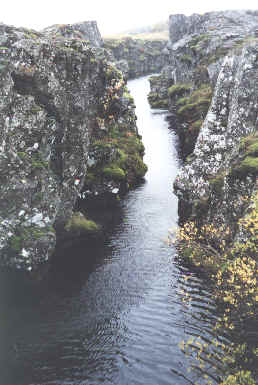
Where Europe meets America, in Iceland where the Mid-Atlantic Rift is above the
ocean.
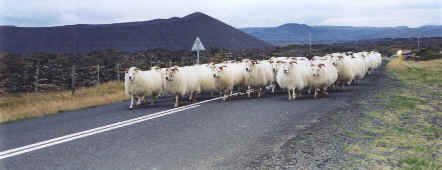
Icelandic sheep walking
along the road.
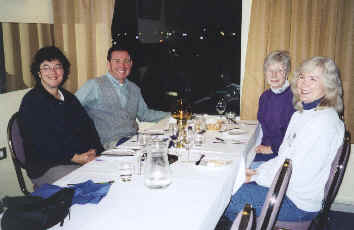
Some of the participants
of our October 2002
Iceland tour.
Upcoming birding & nature tours in Iceland
![]()
ICELAND - June 2002
The following account written by Armas Hill, leader of
the tour.
On June 10, 2002, as midnight
approached, we were at the front of our hotel in the small Icelandic town of Stykkisholmur,
on the shore of the large bay called Breidafjordur.
During our annual Icelandic tours in October, from the very same place, after
dark, we've seen some tremendous displays in the sky of "Northern
Lights" or Aurora Borealis.
As we were there during our June 2002 tour, in the sky at midnight the orange
ball of the Sun lingered low in the sky. It was near the horizon, appearing as
if it were soon to set. But instead our "Midnight Sun" continued to
slide ever so gradually to the north. About 40 minutes later, it finally slipped
below the horizon, above which it would rise the following hour. The fishing
town Stykkisholmur is not far (only about 50 miles) south of the Arctic Circle.
It was quite an experience to see a full, bright disk of a "Midnight
Sun" in the sky from this same place where previously we've seen overhead
the colorful floating forms of the Northern Lights. Both of the phenomena
were so beautiful, in a land where the air is about as clear as it can be
anywhere.
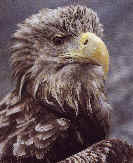
An Icelandic adult
White-tailed Eagle
The following morning, from a
boat, on the large bay called Breidafjordur, we enjoyed some other wonderful
sights, including an adult White-tailed Eagle, sitting on its nest, atop
a rock ledge, with the frosty feathers of its head blowing in the wind, while
nearby there were Puffins, dozens of them, standing on the cliff-tops,
flying about, and swimming in the water. The captain of the boat told us that
examination of the eagle's nest, the previous year after the young had fledged,
showed there to be many bones and other remnants of puffins.
The White-tailed Eagle has a large range, from Greenland east to Hokkaido,
Japan, and north of there in Siberia. But nowhere else in that range would a
prime food of the eagles in the summer be the Atlantic Puffin. There are not
many White-tailed Eagles in Iceland, only about 50 pairs. On the other hand, in
Iceland, there are many Atlantic Puffins, with more nesting there than
anywhere else in the world, about 3 million pairs.
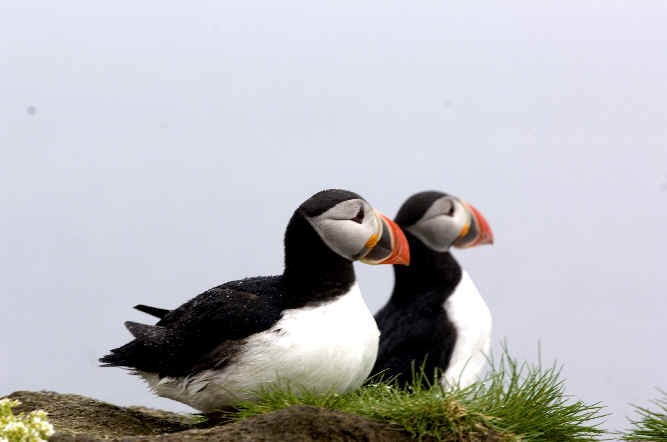
Puffins in Iceland
Other enjoyable sights from the
boat on Breidafjordur included numerous Common Eiders (with the males in
brilliant plumage), Black Guillemots with their bright red feet, swimming
in the water next to us, and Shags with their green eyes, sitting still
cliffside on their nests (yes, the boat did get close enough to the cliff for us
to see in our binoculars the green of the eyes).
A couple days earlier, we were in eastern Iceland, near the coast, by a very
large glacial area called Vatnajokull. This
vast ice-cap is said to be the third largest in the world, after those of
Antarctica and Greenland. Near where the glacier is close to the sea, on big
chunks of ice, some quite blue, there were large flocks of resting birds: mostly
Kittiwakes, also Arctic Terns.
In the water, near the boldly-patterned Eiders, there were
ever-so-colorful Harlequin drakes. Nearby, on a small pond, there was a
pair of breeding-plumaged Red-throated Loons in breeding plumage.
But the highlights of eastern Iceland had to have been the Skuas and Jaegers.
We saw Great Skuas, walking on the gravel where they would nest. One was
seen displaying to another. Wow! In that region of Iceland, nearly half of the
Great Skua global population breeds, between 5 and 6 thousand pairs.
The Parasitic Jaegers in that area, and elsewhere in Iceland, were tremendous to
see, in flight and on the ground. Interesting was the large number of these
jaegers that were dark morphs. According to the literature, about a third of the
jaegers that nest in Iceland are dark.
Very impressive, during our tour, were huge numbers of Northern Fulmars.
There were millions. Nearly every cliffside had swarms of them flying about,
with as many sitting on the ledges. Historically, Fulmars were not common in
Iceland. They certainly are now. At one place, where there was a spectacular,
large waterfall on the side of a tall cliff, as I looked at a group a tourists,
I thought of how they must have thought that the many birds flying about, with
stiff wingbeats, were "gulls".
Another species, also numerous, was the Arctic Tern. At one point, as we
drove along a dirt road, we passed right through a large colony. We stopped our
vehicle and were surrounding by the mass of flying, sitting, and calling birds.
These birds are said to migrate, when away from Iceland, more than any other
species, going thousands of miles to southern Africa, and even beyond into the
Indian Ocean. As we were there, they were sitting on that dirt, ahead of us, and
behind us, by the hundreds.
When we continued further along the road, we found ourselves at a rocky coast
with thousands of other seabirds: Gannets, Kittiwakes, Common and Thick-billed
Murres, and Razorbills. By our parked vehicle, there was another
black-and-white bird, a male Snow Bunting, in breeding plumage, singing
its song.
In the interior of Iceland, high on tundra, we saw a flock of Pink-footed
Geese (Iceland is a prime breeding locality for the species). At another
place, there was a Rock Ptarmigan doing its display flight.
Actually, during the tour, we saw a number of breeding birds, of various
species, displaying. And among them a number of shorebirds: European Golden
Plover, Ringed Plover, Eurasian Oystercatcher, Whimbrel, Common Redshank,
and Common Snipe. And, about as attractive as a breeding shorebird can
be, there were pairs of Red-necked Phalaropes spinning on pools.
On lowland fields, sometimes near the famous Icelandic Horses, were pairs of Whooper
Swans. They did not yet have their cygnets. However, we did see female eiders
sometimes with groups of a dozen or more ducklings (according to the books,
some adults of the species raise their young and those of others). Ravens
were seen at their nests. On lawns and fields, thrushes known as Redwings
were paired, with their young of the year to come. Other passerines included Northern
Wheatear and White Wagtail, Meadow Pipit, and a resident race of the Wren.
Having such fine birding, in such a fascinating and picturesque country, was
certainly a wonderful experience for all 9 of us on the tour.
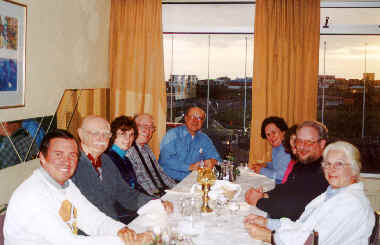
FONT tour group in
Iceland, June 2002.
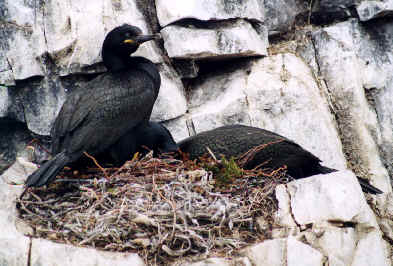
Shags nesting near
Stykkisholmur, Iceland.
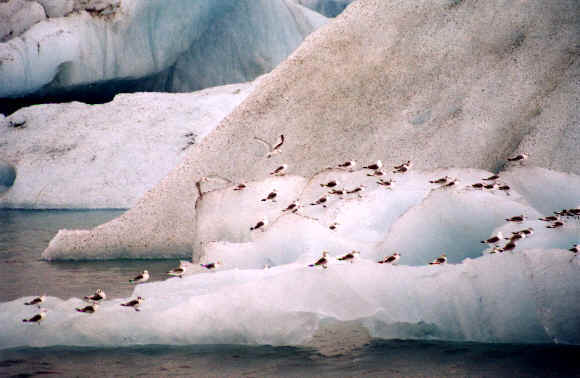
Flocks of Kittiwakes on
Iceland glacial ice, June 2002.
The following came by e-mail to FONT from June 2002 Iceland tour participants after the
tour:
From Rebecca & Jack Matlock, of Princeton, New Jersey, USA:
Dear Armas,
We enjoyed every minute of our
recent tour with you in Iceland... Again, thanks, thanks.